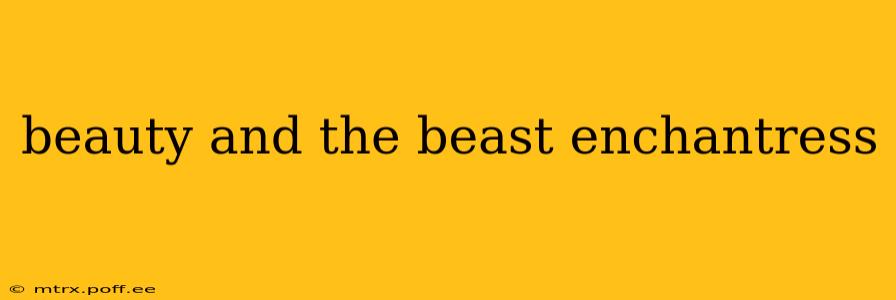The Enchantress in Disney's Beauty and the Beast remains a captivating enigma, a figure whose motivations and backstory are largely left to the audience's imagination. While her presence is fleeting, her impact on the narrative is profound, shaping the entire story and its central conflict. This article delves deeper into the Enchantress, exploring her role, her potential motivations, and the questions surrounding her enigmatic character.
Who is the Enchantress in Beauty and the Beast?
The Enchantress is the powerful sorceress who curses the Prince, transforming him into the Beast. She appears only briefly in a flashback sequence, her face obscured by shadow, adding to her mysterious nature. Her magic is potent, capable of transforming not only the Prince but also his castle and its inhabitants. While we never learn her name, her actions are the catalyst for the entire story, making her a pivotal character despite her limited screen time. Her appearance is often described as regal and intimidating, reflecting her immense power.
What is the Enchantress's Motivation?
This is where speculation truly begins. While the film never explicitly states her motivation, it's generally understood that she's acting as a force of justice, punishing the Prince for his arrogance and cruelty. Her curse is a test, a trial by adversity designed to change the Prince's heart. The enchanted rose acts as a time constraint, symbolizing the urgency of his transformation. This interpretation aligns with the fairytale tradition of moral lessons and karmic consequences.
However, some viewers have proposed alternative interpretations. Was she motivated by personal revenge? Did she have a prior connection to the Prince or his family? These possibilities add layers of complexity to her character, suggesting a deeper, possibly more nuanced, motivation than simple justice. The film deliberately leaves these questions unanswered, allowing audiences to form their own conclusions.
Why Did the Enchantress Curse the Prince?
The film clearly shows the Prince's unkind rejection of the Enchantress, highlighting his superficiality and lack of compassion. This rejection is the direct cause of the curse. However, the extent of his cruelty before this encounter remains unclear. The curse is, therefore, a consequence of his arrogance and lack of empathy, serving as a severe punishment designed to foster personal growth and self-reflection. The urgency of the curse, linked to the enchanted rose's petals, emphasizes the time-sensitive nature of his redemption.
Was the Enchantress Good or Evil?
This is a complex question, indicative of the film's nuanced portrayal of morality. The Enchantress is certainly powerful, and her methods are drastic. Yet, her ultimate goal appears to be rehabilitation, not destruction. She presents the Prince with an opportunity for redemption, a chance to earn back his humanity. This makes classifying her as purely "good" or "evil" simplistic. She is a force of karmic justice, a powerful entity who dispenses consequences and facilitates transformation.
How Does the Enchantress's Role Affect the Story?
The Enchantress's actions set the entire plot in motion. Without her curse, there would be no Beast, no Belle, and no transformative love story. Her role is not simply a catalyst; she shapes the central theme of redemption and the importance of inner beauty. Her absence is felt throughout, her presence lingering as a looming consequence of the Prince's actions. The enchanted rose serves as a constant reminder of her power and the limited time for redemption.
In conclusion, the Enchantress in Beauty and the Beast is a compelling figure whose mystery adds depth to the narrative. While her role is brief, her impact is immense, prompting discussion and interpretation long after the credits roll. The ambiguity surrounding her motivations and intentions enriches the story, encouraging viewers to consider the complexities of justice, redemption, and the power of transformative love.
